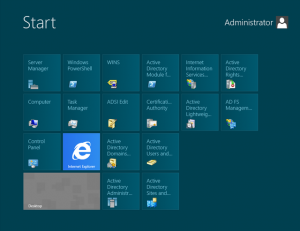The launch of Microsoft’s new Server operating system is upon us, presenting server administrators with some rather exciting developments going forward into 2013, with a particular emphasis on virtualisation and the control system admins have over each virtual machine. This short guide will help you understand the various new developments on offer, introducing you to a new way of interacting with your services.
User Interface
 The first thing you’re going to notice is the interface. This is the first major departure Microsoft has made from its trusted desktop environment for its server operating system, adopting the new tile layout (Metro) first seen in Windows 8 earlier this year. You can opt to stick to a more traditional desktop environment if you wish, but we certainly feel this will add some variation to how administrators control their machines. This new user interface has been said to make it far easier to manage multiple servers more quickly and efficiently.
The first thing you’re going to notice is the interface. This is the first major departure Microsoft has made from its trusted desktop environment for its server operating system, adopting the new tile layout (Metro) first seen in Windows 8 earlier this year. You can opt to stick to a more traditional desktop environment if you wish, but we certainly feel this will add some variation to how administrators control their machines. This new user interface has been said to make it far easier to manage multiple servers more quickly and efficiently.
Server Core
Server Core is a new function of the Windows Server operating system. It is a command line only version of the OS, perfect for more advanced users who have no need for the advanced graphical user interface. The most important function of Server Core is that it can be enabled/disabled without a reinstall.
New Editions
Microsoft have reinvented their range of editions for this new release, scrapping Enterprise, Small Business Server, Web and HPC versions in favour of a more concise 4-edition setup. The new versions are Foundation, Essentials, Standard, and Datacenter (listed here in order of price/feature set, lowest to highest).
Licencing Changes
Linked to this is a new way of licencing the operating system – Server 2012 is now licensed per server as usual for the lower end Foundation and Essentials editions, and per CPU for Standard and Datacenter. The Datacenter edition becomes more cost effective as the number of instances grow. Standard and Datacenter editions of Server 2012 have advanced virtualisation options;
The New Home of Hyper-V
 One of the key features of Server 2012 is its in-built server virtualisation functionality. While the two entry level editions have very limited virtualisation options (as they are designed primarily for basic single server deployments), Standard and Datacenter both have powerful Hyper-V functionality built right into the core, meaning the base operating system can form the basis of a virtual cloud server setup.
One of the key features of Server 2012 is its in-built server virtualisation functionality. While the two entry level editions have very limited virtualisation options (as they are designed primarily for basic single server deployments), Standard and Datacenter both have powerful Hyper-V functionality built right into the core, meaning the base operating system can form the basis of a virtual cloud server setup.
The Cloud OS
Having already been dubbed as Microsoft’s ‘Cloud OS’, Windows Server 2012 Datacenter can support very large virtual environments, supporting up to 1024 virtual machines per host server. Each virtual machine in this version of Hyper-V can access up to 32 virtual processors, up to 512 gigabytes of random-access memory, and up to 16 terabytes of virtual disk space per virtual hard disk.
IIS 8.0 is Here
Microsoft’s latest version of Internet Information Services supports a range of new features, including per-site CPU capping – another indication of the shift towards shared cloud computing.
Impressive Scale for the Data Centre Environment
Windows Server 2012 supports 640 logical processors, 4TB of RAM, and can work inside a cluster of up to 64 nodes.
Optimised for the Cloud
 This latest version of the Microsoft Server operating system has been built from the ground up to support cloud platforms. As such, it is perfectly suited to those looking to host virtual machines, databases, applications (SaaS), web hosting, and even desktop hosting. Microsoft’s in-built System Center 2012 handles much of the cloud service management, managing the computing, storage, and network components of the server.
This latest version of the Microsoft Server operating system has been built from the ground up to support cloud platforms. As such, it is perfectly suited to those looking to host virtual machines, databases, applications (SaaS), web hosting, and even desktop hosting. Microsoft’s in-built System Center 2012 handles much of the cloud service management, managing the computing, storage, and network components of the server.
There is no doubt that Microsoft have made giant leaps forward in releasing this new server operating system. Is is perfect for dedicated server operators, cloud service providers, multi-use clusters, and general data centre operations. The user experience has been drastically simplified, despite the number of features within the OS growing dramatically.
Netwise Hosting will be rolling out Windows Server 2012 in both Standard and Datacenter guises shortly. If you would like to know more about our implementation of this new operating system, please feel free to contact a member of the team.

Looks like a good update
The Metro UI is stupid, so unneccssary for server use… ill stick to 2003.
Looks like the best refresh to the server OS to date.
Metro could be good on servers
Good guide.